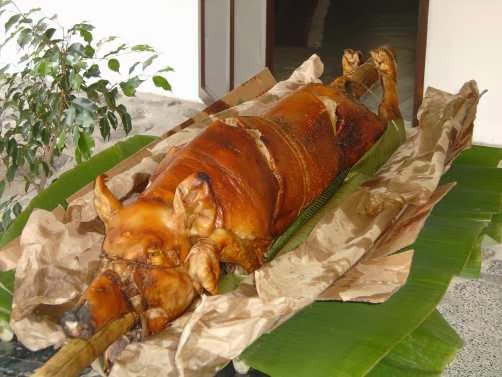
The following article, I have read a couple of years ago. But today, a friend e-mailed it to me. I can help but smile and I decided to share it with you. If you have read this before, my apology. It was written by a British journalist, Matthew Sutherland, stationed in the Philippines. His observations are so hilarious but true!
Sutherland wrote about Filipinos craze of food! This reminded me of the latest tourism video advertising saying that, Filipinos would say
"Have You Eaten Already instead of Hello or Hi"?.
"I have now been in this country for over six years, and consider myself in most respects well assimilated. However, there is one key step on the road to full assimilation, which I have yet to take, and that's to eat BALUT.
The day any of you sees me eating balut, please call immigration and ask them to issue me a Filipino passport. Because at that point there will be no turning back. BALUT, for those still blissfully ignorant non-Pinoys out there, is a fertilized duck egg. It is commonly sold with salt in a piece of newspaper, much like English fish and chips, by street vendors usually after dark, presumably so you can't see how gross it is.
Food dominates the life of the Filipino. People here just love to eat. They eat at least eight times a day. These eight official meals are called, in order: breakfast, snacks, lunch, merienda, merienda cena, dinner, bedtime snacks and no-one-saw-me- take-that- cookie-from- the-fridge- so-it-doesn't-count.
The short gaps in between these mealtimes are spent eating Sky Flakes from the open packet that sits on every desktop. You're never far from food in the Philippines. If you doubt this, next time you're driving home from work, try this game. See how long you can drive without seeing food and I don't mean a distant restaurant, or a picture of food. I mean a man on the sidewalk frying fish balls, or a man walking through the traffic selling nuts or candy. I bet it's less than one minute.
Here are some other things I've noticed about food in the Philippines :
Firstly, a meal is not a meal without rice - even breakfast. In the UK , I could go a whole year without eating rice. Second, it's impossible to drink without eating. A bottle of San Miguel just isn't the same without gambas or beef tapa. Third, no one ventures more than two paces from their house without baon (food in small container) and a container of something cold to drink. You might as well ask a Filipino to leave home without his pants on. And lastly, where I come from, you eat with a knife and fork. Here, you eat with a spoon and fork. You try eating rice swimming in fish sauce with a knife.
One really nice thing about Filipino food culture is that people always ask you to SHARE their food. In my office, if you catch anyone attacking their baon, they will always go, "Sir! KAIN TAYO!" ("Let's eat!").
This confused me, until I realized that they didn't actually expect me to sit down and start munching on their boneless bangus. In fact, the polite response is something like, "No thanks, I just ate." But the principle is sound - if you have food on your plate, you are expected to share it, however hungry you are, with those who may be even hungrier. I think that's great!
In fact, this is frequently even taken one step further. Many Filipinos use "Have you eaten yet?" ("KUMAIN KA NA?") as a general greeting, irrespective of time of day or location.
Some foreigners think Filipino food is fairly dull compared to other Asian cuisines. Actually lots of it is very good: Spicy dishes like Bicol Express (strange, a dish named after a train); anything cooked with coconut milk; anything KINILAW; and anything ADOBO. And it's hard to beat the sheer wanton, cholesterolic frenzy of a good old-fashioned LECHON de leche (roast pig) feast.. Dig a pit, light a fire, add 50 pounds of animal fat on a stick, and cook until crisp. Mmm, mmm... you can actually feel your arteries constricting with each successive mouthful.
I also share one key Pinoy trait --- a sweet tooth. I am thus the only foreigner I know who does not complain about sweet bread, sweet burgers, sweet spaghetti, sweet banana ketchup, and so on. I am a man who likes to put jam on his pizza. Try it!
It's the weird food you want to avoid. In addition to duck fetus in the half-shell, items to avoid in the Philippines include pig's blood soup (DINUGUAN); bull's testicle soup, the strangely-named "SOUP NUMBER FIVE" (I dread to think what numbers one through four are); and the ubiquitous, stinky shrimp paste, BAGOONG, and it's equally stinky sister, PATIS. Filipinos are so addicted to these latter items that they will even risk arrest or deportation trying to smuggle them into countries like Australia and the USA , which wisely ban the importation of items you can smell from more than 100 paces.
Then there's the small matter of the purple ice cream. I have never been able to get my brain around eating purple food; the ubiquitous UBE leaves me cold.
And lastly on the subject of weird food, beware: that KALDERETANG KAMBING (goat) could well be KALDERETANG ASO (dog)...
The Filipino, of course, has a well-developed sense of food. Here's a typical Pinoy food joke: "I'm on a seafood diet.
"What's a seafood diet?" "When I see food, I eat it!"
Filipinos also eat strange bits of animals --- the feet, the head, the guts, etc., usually barbecued on a stick. These have been given witty names, like "ADIDAS" (chicken's feet); "KURBATA" (either just chicken's neck, or "neck and thigh" as in "neck-tie"); "WALKMAN" (pigs ears); "PAL" (chicken wings); "HELMET" (chicken head); "IUD" (chicken intestines), and BETAMAX" (video-cassette- like blocks of animal blood). Yum,yum. Bon appetit."
My Personal Note: You know you are in the Philippines when you see restaurants of all class and types all around. For example in the Makati area there must be hundreds of restaurants per square mile, but they all survive and are profitable. When Pinoys get depressed they turn to food. I wonder what percent of the Filipino people are overweight?

































